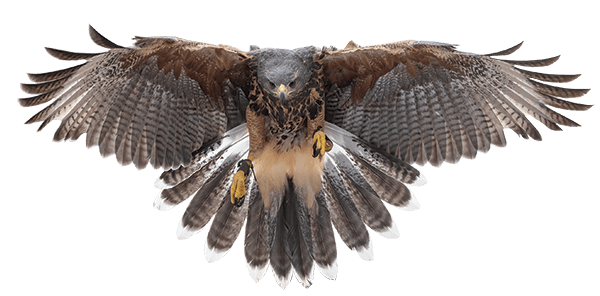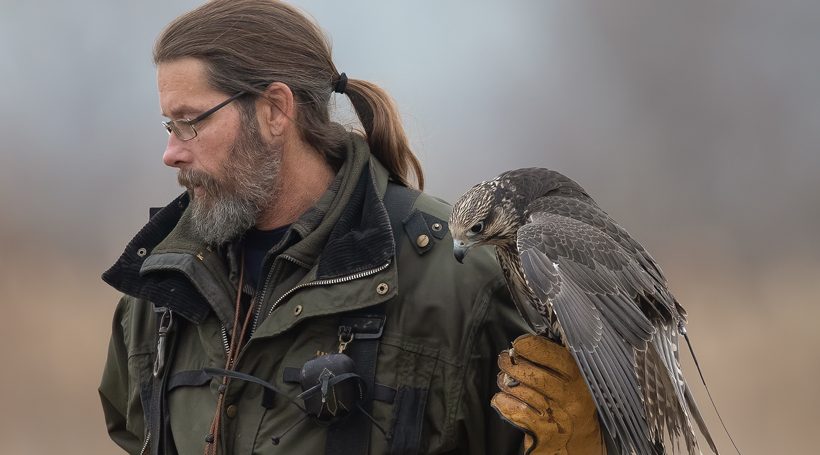Erik Swanson Photo: Ray Gilbert
The seagulls were out of control. They’d always been scavengers, swiping French fries from buckets when backs were turned and crowding trash cans, looking for scraps. But by 2019 the flocks had gotten bigger, and the birds on Ocean City’s beach and boardwalk were becoming an intrusive problem.
“The gulls had figured out how to turn people into human vending machines,” says Erik Swanson. “A young kid has food. They figured out they could bite him and that kid will drop everything he’s got, and mom and dad will drop whatever they’ve got and come running. I think the majority of people really think birds are kind of stupid, but the intelligence level on ’em is high.”
The Shore town had tried everything to control the gulls. Then they called Swanson, who arrived with birds of his own. Swanson is a falconer and the owner of East Coast Falcons, a service that uses raptors to deal with nuisance birds by simply scaring them off.
“Most of the places I work have one thing in common: they’ve tried everything,” Swanson says. “Kites, balloons, Mylar tape, squawk boxes, propane cannons – anything that’s supposed to scare birds away.”
Even the most aggressive of those tactics only work temporarily, he says, because the nuisance birds, like Ocean City’s seagulls, simply get used to them. But there’s no getting used to a natural predator.
“Every bird is afraid of a falcon, a hawk or an owl,” Swanson says. “We fly our birds, and the other birds learn quick that this is a hostile area. The first thing the gulls do when you put up a falcon is run for the water, away from the beach and the boardwalk. It’s genetically imprinted into their brains to be afraid of that shape.”
By the end of East Coast Falcons’ first year in Ocean City, Swanson says locals started seeing seagulls out on sandbars, catching fish and breaking open clams.
“Nothing scares a bird more than an owl. They’re complete stealth.”
“Residents told me they’d never seen the birds actively fishing,” he says. “They’d always depended on people for food, but we got them back to their natural behavior.”
Swanson has a team of about a half-dozen falconers in Ocean City, working 12-hour shifts with various raptor species. The falconer on duty heads out to the beach or boardwalk and releases the bird, which is trained to simply fly for a while, then return when it’s called.
“We fly them a little bit high,” says Swanson, referring to the birds’ weight (not altitude), which is carefully kept on the higher end of the healthy range. In other words, they aren’t hungry.
“They have enough energy to fly, and they’ll chase the nuisance birds, but they’ll come back when we ask them to, and they probably won’t commit to a kill,” says Swanson.
Swanson has just over a dozen raptors at the moment, each specialized to certain tasks and environments. “We use a lot of hybrids for the summer work in Ocean City – peregrines crossed with desert species,” he says. “They can handle the long hot days so much better.”
But not all of Swanson’s work happens during the day.
“The boardwalk is pretty well lit up, and after we started flying our birds during the day, the gulls learned to come at night,” Swanson says. So he brought in a new weapon: a European eagle owl, about twice the size of a great horned owl and – if you’re a seagull – utterly terrifying.
“Nothing scares a bird more than an owl,” Swanson says. “They’re complete stealth. They come in out of nowhere and snatch you right off the spot where you’re sitting. We brought our owl in, and after 2 or 3 flights I don’t think we’ve seen a gull there at night again.”
Swanson’s been working as a falconer for almost 30 years, but he stumbled into the profession almost by happenstance.
“I used to train narcotic and patrol dogs for police and military,” he says. “I got kind of tired of that, and decided to switch to exotics.”
Swanson was working at Turtle Back Zoo in West Orange in the 1990s, training mostly big cats and wolves, when he met his first raptor, the zoo’s massive golden eagle.
“I started a program training birds for free-flight demonstrations,” he says. “We acquired a few more bald eagles, we had great horned owls and barred owls and great greys. All kinds of falcons, from kestrels to peregrines.”
He got into abatement by chance, too.
“A friend of someone at the zoo came to us about this goose problem at a golf course,” he says. “They said, ‘Do you think you could solve it with a falcon?’ And once I saw how it worked, I just thought wow, this is it.”
For the last few decades, Swanson has traveled up and down the East Coast, using his raptors to solve all kinds of bird issues. He’s chased pigeons away from new construction and parking garages, scared birds off airport runways and helped farmers preserve their crops.
“We helped out a blueberry farmer who was having a problem with big flocks of starlings,” Swanson says. “In one of the fields they were losing between 40-60% of their crop. We got them down to 5%.”
He’s also cleared plenty of geese from golf courses, parks and sports fields.
“For that, we use a dog and a big falcon,” he says. “On the ground, geese will fight. But in the air, the falcon has the upper hand. So you use the dog – I use miniature dachshunds – to make the geese fly, and the falcon takes a shot at them. It’s really effective. Scares the bejeesus out of the geese.”
By restoring the natural relationship of predator and prey, and controlling nuisance birds through fear rather than by trapping or killing them, Swanson feels he’s helping both his clients and the ecosystems he works in.
“A raptor isn’t like a shotgun that you just put in a closet when you’re done with it,” he says. “Our tool – we can’t tell it exactly what to do. It’s a different tool, a more humane tool.”
It’s also a bit more unpredictable and requires a lot of skill to wield.
“You have to really be in tune – you can’t make the falcon do what it doesn’t want to do,” Swanson says. “It has to really want to work. If you try to force them, you could end up killing them in the heat, or they could just say ‘I quit’ and fly away.”
That does happen, even with Swanson’s well-trained birds. When he first started out in falconry, he’d have to find a lost bird by following the sound of the bells tied to its feet. Now, there’s modern tech involved.
 “There’s a tiny GPS transmitter we clip on their back or their foot, and we know everything,” he says. When a bird doesn’t come back to its handler, he can follow the signal to find the building or tree where it’s perched.
“There’s a tiny GPS transmitter we clip on their back or their foot, and we know everything,” he says. When a bird doesn’t come back to its handler, he can follow the signal to find the building or tree where it’s perched.
“Plus, I get to see how high my birds go, and how fast they move,” Swanson adds. “I can be like, ‘Wow, she’s chasing something, she hit 160 miles an hour!’”
Maybe that seems fast, but Swanson shrugs it off. “The fastest I’ve had – where I know the GPS is right – is 210 miles per hour. Other people have claimed 260 or 280.”
When falcons dive, he explains, they can pass terminal velocity (the physics term for the maximum speed at which an object can fall, factoring in gravity and air resistance). “The birds change their shape and slip the airstream. Look at a picture of a falcon in a dive and a stealth bomber. It doesn’t look that much different.”
No wonder the seagulls are scared.














